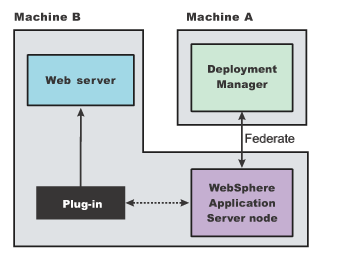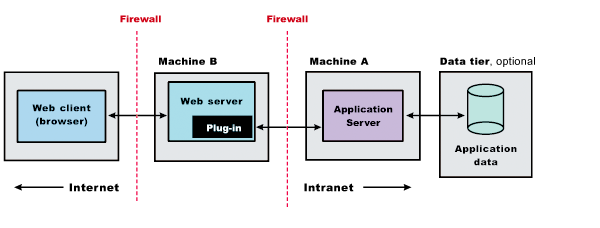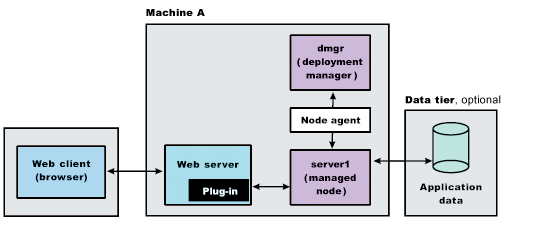Network Deployment (Distributed operating systems), v8.0 > Set up intermediary services > Implement a web server plug-in
Configure web server plug-ins
WAS supplies a unique binary plug-in module for each supported web server. The plug-in configuration file, which the WAS products create and maintain, interacts with the binary module to provide information about the application server configuration to the web server. The web server uses the information to determine how to communicate with the application server.
 For transitioning users: In WAS v7
and earlier, you use the Plug-ins installation wizard to install the plug-in module, configure the web server for communicating with the application server, and create a web server configuration definition in the application server if possible. In WAS v8
and later, first install the Web Server Plug-ins, the web server, and the WebSphere Customization Toolbox; then, you run the Web Server Plug-ins Configuration Tool that is contained in the toolbox to configure the web server to communicate with the application server and, if possible, create a web server configuration definition in the application server. If you know how to set up your initial web server and plug-in configuration manually, you can do so in Version 7 and v8.trns
For transitioning users: In WAS v7
and earlier, you use the Plug-ins installation wizard to install the plug-in module, configure the web server for communicating with the application server, and create a web server configuration definition in the application server if possible. In WAS v8
and later, first install the Web Server Plug-ins, the web server, and the WebSphere Customization Toolbox; then, you run the Web Server Plug-ins Configuration Tool that is contained in the toolbox to configure the web server to communicate with the application server and, if possible, create a web server configuration definition in the application server. If you know how to set up your initial web server and plug-in configuration manually, you can do so in Version 7 and v8.trns
See Web server plug-in policy for WAS for information about how to verify what plug-in versions are installed on local or remote web servers and how to determine if the installation complies with supported configurations.
We must install a supported web server before you can install and configure a plug-in for the web server.
The Web Server Plug-ins Configuration Tool configures the web server for communicating with the application server and creates a web server configuration definition in the application server if possible.
Some topologies, such as the web server on one system and the application server on another system, prevent the Web Server Plug-ins Configuration Tool from creating the web server definition in the application server configuration directly on the remote system. In such a case, the Web Server Plug-ins Configuration Tool creates a script that you can copy to the application server system. Run the script to create the web server configuration definition within the application server configuration.
This article describes installing and configuring web server plug-ins for WAS. WAS products supplies a unique binary plug-in module for each supported web server. The plug-in configuration file, which the WAS products create and maintain, interacts with the binary module to provide information about the application server configuration to the web server. The web server uses the information to determine how to communicate with the application server.
The Web Server Plug-ins Configuration Tool configures the web server and the application server to allow communication between the servers.
Tip: As an alternative to using the Web Server Plug-ins Configuration Tool, you can use the pct command-line tool with a response file to configure a web server. Read Configure a web server plug-in using the WCT command-line utility for more information.
Select one of the following topology scenarios and follow the steps below the diagram to install the plug-in and configure both the web server and the application server.
When multiple profiles exist, you can select the profile that the Web Server Plug-ins Configuration Tool configures. See Plug-ins configuration for a description of the flow of logic that determines how to select the profile to configure.
Procedure
- Scenario 1: Local application server profile The application server and the web server are on a single system or logical partition.

A local distributed installation includes the Web server plug-in, the web server, and a managed application server on the same system:

See Configure a web server and an application server profile on the same machine for the procedure that explains how to create this web server topology for an application server profile.
- Scenario 2: Remote The application server and the web server are on separate machines or logical partitions.

See Configure a web server and an application server on separate machines (remote) for the procedure that explains how to create this web server topology.
- Scenario 3: Remote Multiple standalone application servers are on one system, and each application server has a dedicated web server on a separate system or logical partition.

See Configure multiple web servers and remote standalone application servers for the procedure that explains how to create this web server topology.
- Scenario 4: Local custom profile A managed node and the web server are on the same system or logical partition.
A local distributed installation includes the web server plug-in, the web server, and the managed custom node on the same system:

See Configure a web server and a custom profile on the same machine for the procedure that explains how to create this web server topology for a federated custom profile.
- Scenario 5: Local dmgr profile A dmgr node and the web server are on a single system or logical partition.
A local distributed installation includes the web server plug-in, the web server, and the application server on the same system:

See Configure a web server and a dmgr profile on the same machine for the procedure that explains how to create this web server topology for a dmgr profile.
Results
We can install a web server and the web server plug-ins for various standalone application server topologies by following the procedures described in this article.
What to do next
See Select a web server topology diagram and roadmap for an overview of the installation procedure.
See Web server configuration for more information about the files involved in configuring a web server.
See Editing Web server configuration files for information about how the Web Server Plug-ins Configuration Tool configures supported web servers.
Related
Select a web server topology diagram and roadmap
Web server configuration
Configure a web server and an application server on separate machines (remote)
Configure multiple web servers and remote standalone application servers
Configure a web server and an application server profile on the same machine
Configure a web server and a custom profile on the same machine
Configure a web server and a dmgr profile on the same machine
Configure a web server plug-in using the WCT command-line utility
Edit web server configuration files
Map modules to servers
Implement a web server plug-in